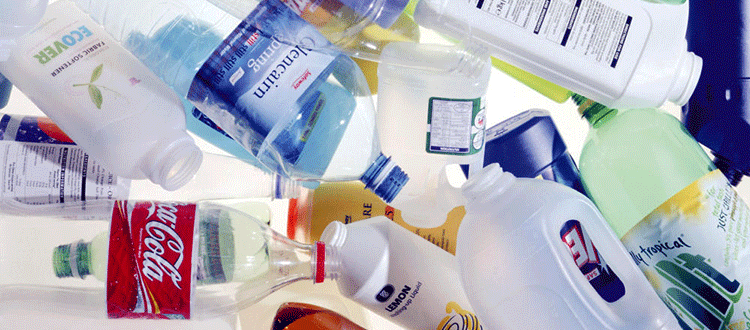Plastuck: Trying to Avoid Toxic Plastic
 |
| Laurie GreigWomen’s Voices Member |
The seven of us sat nervously in the cancer ward, waiting to hear the prognosis for Katy, my 27-year-old goddaughter recently diagnosed with Stage Three breast cancer. The balding oncologist began by pointing at the grocery store water bottles in our hands. “Do you know that these types of plastic water bottles are known to be cancer-causing?”
As he continued enumerating the carcinogenic properties of plastics, sharing too many painful details about the massive tumor in Katy’s young breast and explaining the forthcoming experimental treatment she would endure—we listened closely, occasionally stealing sips of water from our toxic bottles.
The doctor informed us that when such bottles are refilled or frozen, the plastic becomes softer and more pliable, leaching synthetic estrogen into the water it contains. Synthetic estrogen, he said, is a known carcinogen.
By the end of the two-hour meeting, it was clear I could not get rid of the cancer in Katy’s body. But I had to do something. That’s when I decided to banish plastic from my life.
As Katy began a 12-week chemo attack on the grapefruit-sized tumor, I staged my own counter offensive on plastic. I sorted old plastic spoons, containers and utensils from their non-plastic counterparts. Have rid my kitchen of Teflon on aluminum years before, I rechecked every pot and pan, tossing the ones with plastic handles. I researched yogurt brands, searching in vain for one that didn’t come packaged in plastic. My goddaughter shaved her head; I bought glass jars and filled them with yogurt culture and scaled milk.
Based on the oncologist’s advice, I stopped buying bottled water, period. Further Internet research revealed that the softer the plastic, the more dangerous it is for human use. I tossed my blue Nalgene with plans to trade it in for a clear plastic version, but instead opted for the stainless steel canteens sold at my local food co-op.
Fortunately, Katy’s tumor was shrinking, and she was going to be able to have a lumpectomy after all. My plastic problem, on the other hand, was getting larger. The closer I scrutinized my daily habits, the more plastic I discovered there.
According to the Wall Street Journal, the United States alone consumes 100 billion plastic bags annually. In 2004, Worldwatch Institute found that only 0.6 percent of plastic bags in the United States are recycled. I had an entire kitchen drawer dedicated to plastic bags, which I used for dog walks, storing food, and the like. I decided the couple of uses I put them through did not justify the non-renewable fossil fuels that went into their production, let alone the eternity they would spend in the landfill.
I committed to a new mantra—“No bag please”—determined to carry my reusable canvas tote wherever I shopped. I sourced compostable “pooper bags” from Norway for the dog. When in a pinch, I accepted the plant polymer biodegradable plastic bags at the natural food stores.
The oncologist had told us that using plastic wrap to cover food heated in a microwave leeches the same synthetic estrogen found in water bottles. The U.S. FDA backs up his warning, advising the public to cool food before putting it in a plastic container. They also discourage storing fatty or oily foods, like meat or cheese, in plastic. I have never owned a microwave and I watch the amount of fatty foods I eat. But now, just thinking about the years of diner dinners—the plastic wrapped apple pies, the mashed potatoes nuked in plastic just before serving—makes me lose my appetite.
As Katy successfully completed her surgery, moving on to seven weeks of radiation treatments, I continued my anti-plastic crusade. With fond memories for the bologna sandwiches of my youth, I revived the ‘50s tradition of waxed paper. I foraged flea markets and garage sales for the colored Pyrex dishes with lids, like those my grandmother used, and packed my leftovers in glass containers with semi-air-tight lids. When it came time to preserve the bounty of summer, I filled my freezer wth glass mason jars of jams, fruits, and veggies, even if they took up more room than sealable plastic bags.
Katy is currently—remarkably, blessedly—cancer-free. But I still continue my campaign, refusing plastic wherever I find it. Because of the type of cancer Katy had, she will never have children of her own. There is so much I would like to do for her. But for now, I’m fighting plastic—one grocery bag, water bottle and yogurt container at a time.
Published in Conscious Choice, November, 2007, page 65.
Laurie M. Greig is a mostly-retired psychotherapist in private practice in Washington State. At the age of 10 she saw a wall of plastic dishes in a California department store. Laurie remembers seeing the wall and thinking “plastics will be the end of human beings.” Unfortunately she has not changed her mind since then.




Great article! Makes me stop & think about all the plastics around here! I will do something. Thanks
Don’t forget the scented laundry products. The amount of chemicals used to make “fragrance” is astounding and your clothing (and bedding) is on your skin, leaching into your blood stream 24 hours a day… So please also add switching to Free and Clear laundry soap and (if you use it) softener/dryersheets. No chemical Scents Makes Sense when it comes to preventing cancer
So very glad that more folks are starting to be aware of the 80,000+ chemicals in the environment. 11,000 are banned in Japan and Europe but not in the U.S. One of the leading causes of children age 15 and under is cancer. We moved back to Idaho a couple of years ago and have realized the difference in Idaho’s awareness/acceptance versus Washington state where we lived for 40+ years. It is a “national issue.